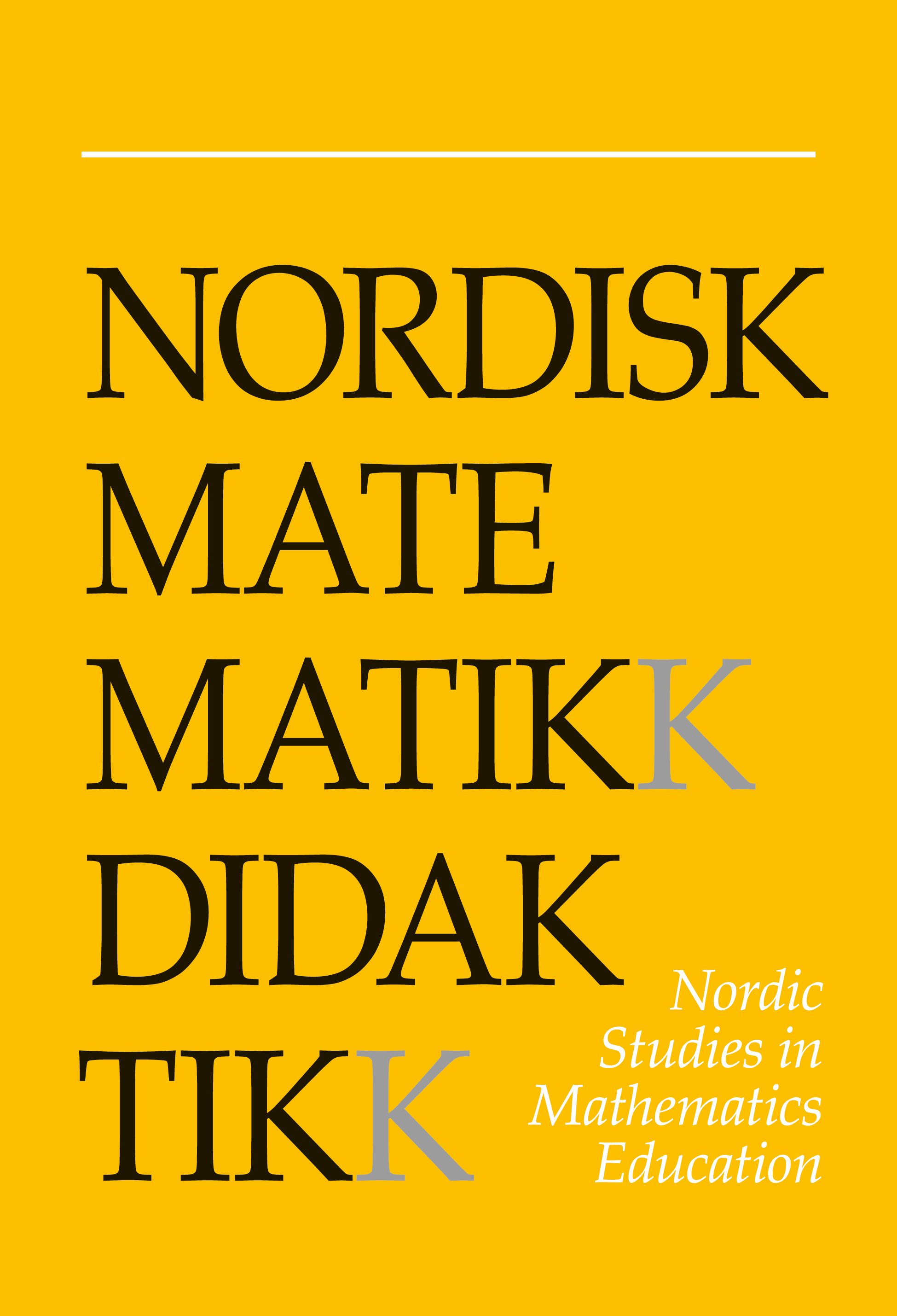Meanings of decision-making in probability and statistics: comparing Chilean and Danish upper secondary school curricula
DOI:
https://doi.org/10.7146/nomad.v25i1.149043Abstract
In this article I investigate the roles given to decision-making in probability and statistics upper secondary school curriculum, in a comparative study between Chile and Denmark. Drawing upon Fairclough’s model for Critical discourse analysis, I analyse selected official curricular texts as examples of broader discursive practices. In particular, I focus on the positioning of social actors and legitimation strategies. Present discourses position students as active decision makers, though in the Chilean case this is only evident in more recent texts. The teaching and learning of probability and statistics are legitimised through the appeal to political, professional and educational authorities, and through narratives of necessity for rational, grounded, evidence-based decisions. In this aspect Danish texts are more open to complex social and political decision processes. The analysis illustrates a common search for linking mathematics education to democratic involvement in social and political decision-making, but failing to specify the relevance of probability and statistics beyond the individual psychological scope.
References
Araneda, A. M., Pino, G. del, Estrella, S., Icaza, G. & San Martín, E. (2011). Recomendaciones para el currículum escolar del eje datos y azar [Recommendations for school curriculum on the axis of data and chance]. Santiago: Sociedad Chilena de Estadística.
Batanero, C., Fernandes, J. A. & Contreras, J. M. (2009). Un análisis semiótico del problema de Monty Hall e implicaciones didácticas [A semiotic analysis of the Monty Hall problem and didactical implications]. Suma: Revista Sobre Enseñanza y Aprendizaje de Las Matemáticas, 62, 11-18.
Beck, U. (2000). Risk society revisited: theory, politics and research programmes. In B. Adam, U. Beck & J. Van Loon (Eds.), Risk society and beyond: critical issues for social theory (pp. 211-229). London: SAGE Publications. https://doi.org/10.4135/9781446219539.n12
Borovcnik, M. (2015). Risk and decision making: the "logic" of probability. The Mathematics Enthusiast, 12(1,2 & 3), 113-139. https://doi.org/10.54870/1551-3440.1339
Chernoff, E. J. & Sriraman, B. (Eds.) (2014). Probabilistic thinking. Dordrecht: Springer Netherlands. https://doi.org/10.1007/978-94-007-7155-0
Dahl, B. & Stedøy, I. M. (2004). A Nordic community: ideas of education and democracy in mathematics. In I. M. Stedøy (Ed.), Mathematics education? The Nordic way (pp. 1-10). Trondheim: TAPIR Akademisk Forlag.
Elicer, R. & Carrasco, E. (2017). Conditional probability as a decision-making tool: a didactic sequence. In T. Dooley & G. Gueudet (Eds.), Proceedings of CERME10 (pp. 748-755). Dublin: ERME.
Ellis, K. (1995). The Monty Hall problem. Retrieved from http://www. montyhallproblem.com
Fairclough, N. (1992). Discourse and text: linguistic and intertextual analysis within discourse analysis. Discourse & Society, 3 (2), 193-217. https://doi.org/10.1177/0957926592003002004
Fairclough, N. (2003). Analysing discourse: textual analysis for social research. London: Routledge. https://doi.org/10.4324/9780203697078
Fairclough, N. (2010). A dialectical-relational approach to critical discourse analysis in social research. In N. Fairclough (Ed.), Critical discourse analysis: the critical study of language (2nd ed., pp. 230-254). Harlow: Routledge.
Gal, I. (2002). Adults' statistical literacy: meanings, components, responsibilities. International Statistical Review, 70 (1), 1-25. https://doi.org/10.1111/j.1751-5823.2002.tb00336.x
Garfield, J. & Ben-Zvi, D. (2007). How students learn statistics revisited: a current review of research on teaching and learning statistics. International Statistical Review, 75 (3), 372-396. https://doi.org/10.1111/j.1751-5823.2007.00029.x
Gigerenzer, G. (2008). Why heuristics work. Perspectives on Psychological Science, 3 (1), 20-29. https://doi.org/10.1111/j.1745-6916.2008.00058.x
Hacking, I. (1975). The emergence of probability: a philosophical study of early ideas about probability, induction and statistical inference. Cambridge University Press.
Kahneman, D. (2011). Thinking, fast and slow. New York: Farrar, Straus and Giroux.
Monteiro, C. & Ainley, J. (2007). Investigating the interpretation of media graphs among student teachers. International Electronic Journal of Mathematics Education, 2 (3), 188-207. https://doi.org/10.29333/iejme/183
Petocz, P., Reid, A. & Gal, I. (2018). Statistics education research. In D. Ben-Zvi, K. Makar & J. Garfield (Eds.), International handbook of research in statistics education (pp. 71-99). Cham: Springer International. https://doi.org/10.1007/978-3-319-66195-7_3
Pfannkuch, M. (2018). Reimagining curriculum approaches. In D. Ben-Zvi, K. Makar & J. Garfield (Eds.), International handbook of research in statistics education (pp. 387-413). Cham: Springer International. https://doi.org/10.1007/978-3-319-66195-7_12
Pratt, D., Ainley, J., Kent, P., Levinson, R., Yogui, C. & Kapadia, R. (2011). Role of context in risk-based reasoning. Mathematical Thinking and Learning, 13 (4), 322-345. https://doi.org/10.1080/10986065.2011.608346
Skovsmose, O. (1998). Linking mathematics education and democracy: citizenship, mathematical archaeology, mathemacy and deliberative interaction. ZDM, 30 (6), 195-203. https://doi.org/10.1007/s11858-998-0010-6
Skovsmose, O. & Valero, P. (2002). Democratic access to powerful mathematical ideas. In L. D. English (Ed.), Handbook of international research in mathematics education (pp. 383-407). Mahwah: Lawrence Erlbaum.
Valero, P. (1999). Deliberative mathematics education for social democratization in Latin America. ZDM, 31 (1), 20-26. https://doi.org/10.1007/s11858-999-0004-z
Van Leeuwen, T. (2007). Legitimation in discourse and communication. Discourse & Communication, 1 (1), 91-112. https://doi.org/10.1177/1750481307071986
Weiland, T. (2017). Problematizing statistical literacy: an intersection of critical and statistical literacies. Educational Studies in Mathematics, 96 (1), 33-47. https://doi.org/10.1007/s10649-017-9764-5
Downloads
Published
How to Cite
Issue
Section
License

This work is licensed under a Creative Commons Attribution-NonCommercial-ShareAlike 4.0 International License.



